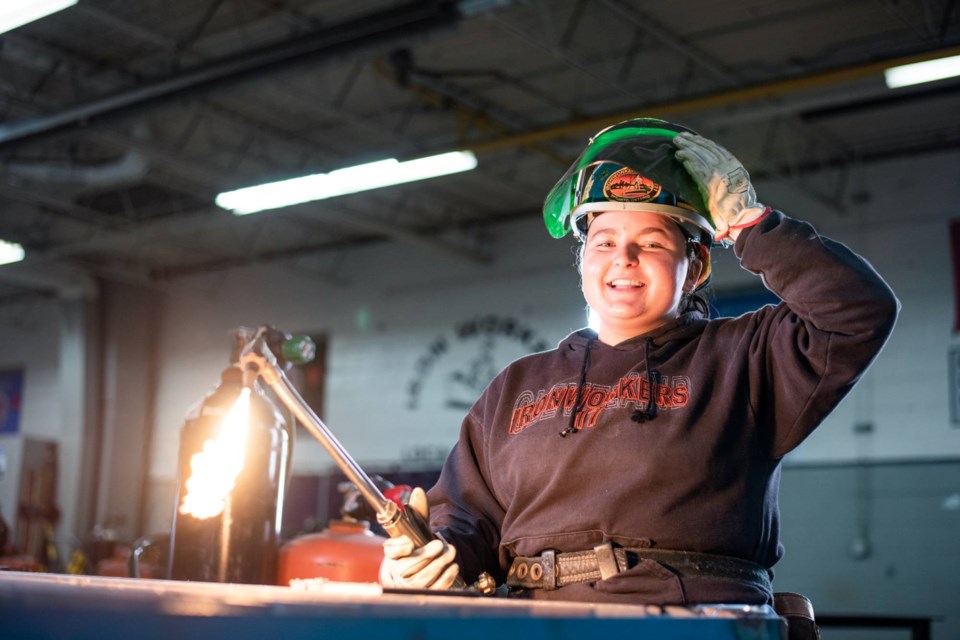Kayla Bailey was on track to attend university when a trip to Red Lake changed everything.
Her mom, who had worked in the construction trades for more than three decades, was starting a job at the local mine and Bailey decided to go along for the ride.
Though she had watched her mom don her orange coveralls daily, Bailey said, she never really knew what the work entailed on a day-to-day basis.
In Red Lake, she met people who loved the variety and challenge of their jobs, who made good salaries that enabled them to purchase homes and vehicles, and who enjoyed a high quality of life. She was smitten.
“It really changed my perspective,” she said. “People were happy and jovial, and… the whole crew was a family, and I was really drawn to that.”
By the time she had returned home, Bailey had decided to follow in her mom’s footsteps, and today she’s a journeyperson steamfitter, a gasfitter, and a welder with the United Association Local 46 in Toronto.
Now she and other tradeswomen from across the province are banding together to raise awareness about the opportunities that the skilled trades can offer women.
Bailey is the project manager with Ontario Building & Construction Tradeswomen (OBCT), a committee established by the Provincial Building and Construction Trades Council of Ontario, whose work is focused on promoting the skilled trades to women and providing support that will help them succeed.
Quietly launched in 2019, the organization began with about 30 women tossing around ideas at a women's summit during the annual conference of the Provincial Building and Construction Trades Council of Ontario. It has grown today to about 400 members, including several in Northern Ontario.
Their work is based on a three-pronged approach to support, recruit, and retain women to the construction and building trades.
With one in three women in their first year of apprenticeship not making it to their second year, Bailey views it as belated, but necessary, work.
“This was needed a long time ago,” she said. “It’s long overdue.”
While there’s no lack of women interested in entering the trades — Bailey said she gets inquiries weekly from women about how to get involved — tradeswomen often still face barriers to succeed.
In some cases, they experience sexual harassment in the workplace.
For others, growth in their careers is stunted because their work isn’t taken seriously, with many feeling pressure to do “125 per cent of the work just to get 100 per cent of the credit,” Bailey said.
Some women struggle to find personal protective equipment in the right size.
One diminutive ironworker Bailey spoke with has to wear five pairs of socks in her work boots just to get them to fit properly. It’s a hazard for someone who relies on good balance to do her job.
“I’ve had a few conversations over the last few weeks with some women that are being put in unsafe positions,” Bailey said.
“They’re not being provided safety equipment, or they’re being provided safety equipment that doesn’t fit and, if anything, is just going to hurt them.”
OBCT works with industry partners to help members find apprenticeships, and also runs training and mentorship programs.
Through mentorship, the organization aims to match mentors and mentees in similar trades and in roughly the same geographical region, which increases the chance they may work together in the future, Bailey said.
Mentors and their mentees decide how much or how little they want to be in contact and how long the mentorship lasts.
The goal is to give new tradeswomen the confidence to ask questions about tools, career advancement, or the nature of the work itself.
“I personally think when you have experience, many answers are so easy to come to,” Bailey said. “But when some of these people are new and young, the answers seem almost impossible to them because they don’t have that experience.”
To get a read on the current climate in the industry, the organization is currently running an online survey for skilled trades employers, union organizers, general foremen, and others in supervisory roles to share their experiences with tradeswomen.
The survey will be available until the end of February, after which the OBCT will compile the results in a report and issue recommendations.
Later this year, the group will begin its work on an anti-harassment course, which Bailey is hopeful will become a mandatory ticketed item in the same vein as WHMIS or working at heights training.
The goal is to help educate those in the industry about appropriate behaviour in the workplace.
“We firmly believe that some of the people out there that are crossing barriers for tradeswomen, some of it’s intentional, but a lot of it is just lack of education,” Bailey said.
“So we do want to rectify that in any way that we can.”
With Canada projecting a shortage of 10,000 workers in Red Seal trades over the next five years, recruiting new workers to the building and construction trades is more important than ever.
Women can play an integral part in closing that gap, but there’s still lots of work to be done to make them feel welcome.
“Most of us that are working in the industry have seen many sisters come and go,” Bailey said, “and it's hard to blame them because some of the challenges are really more than most people bargained for when they sign up for a job.”




